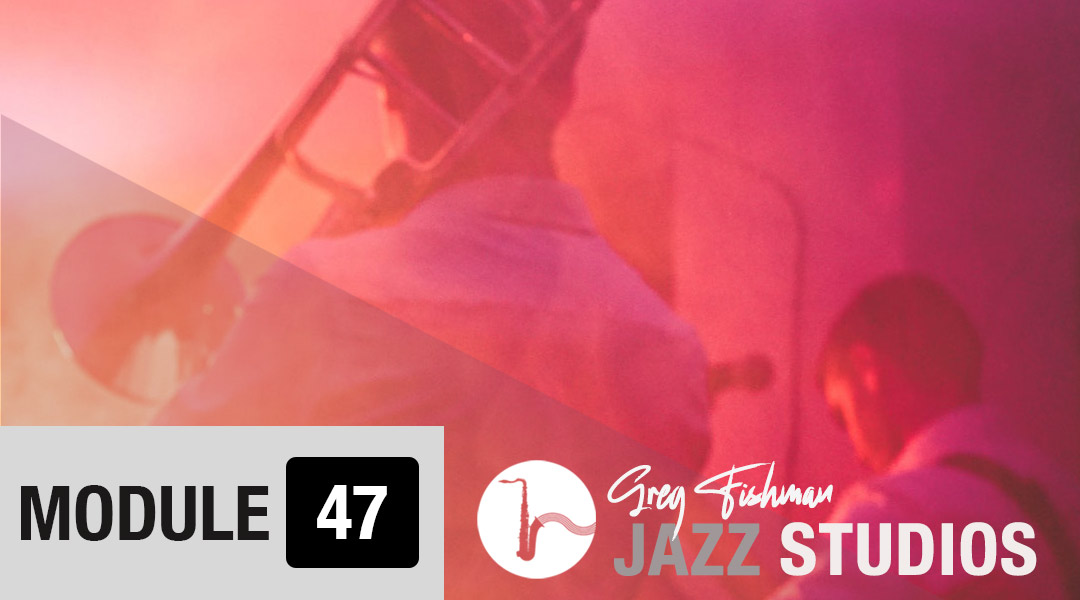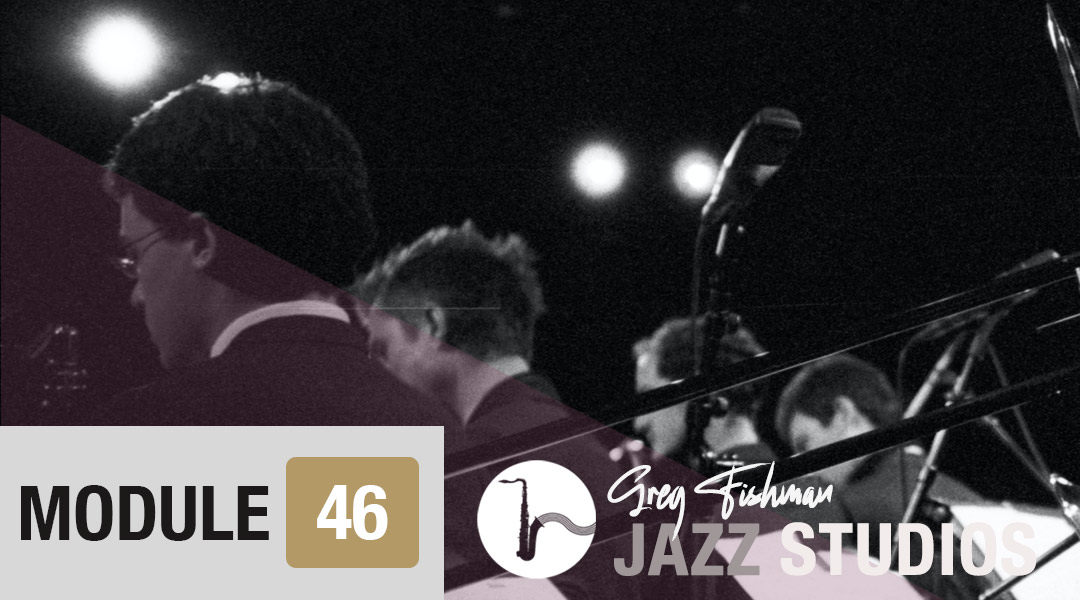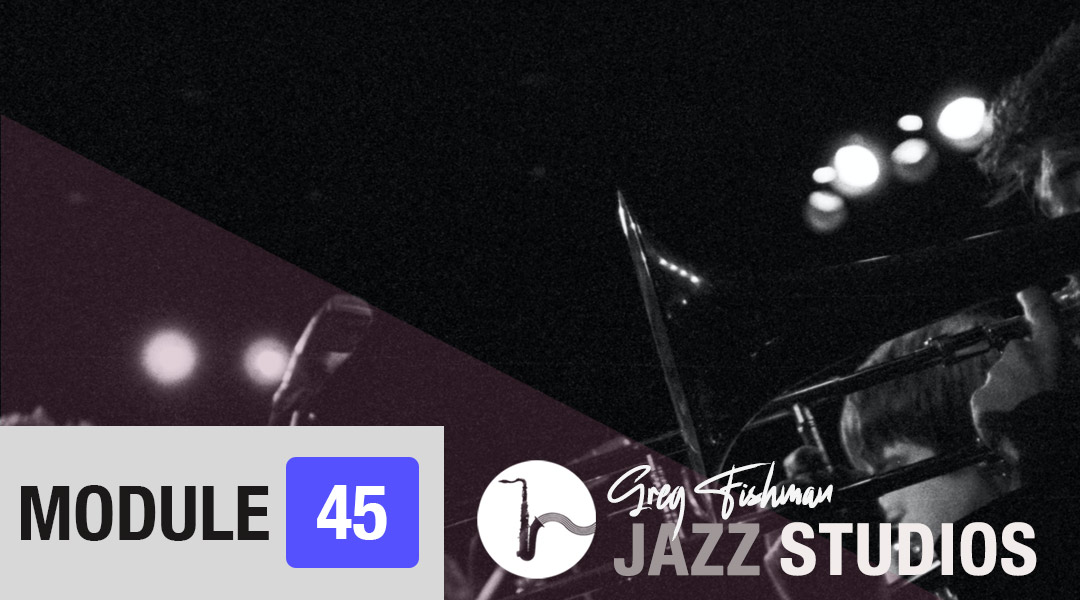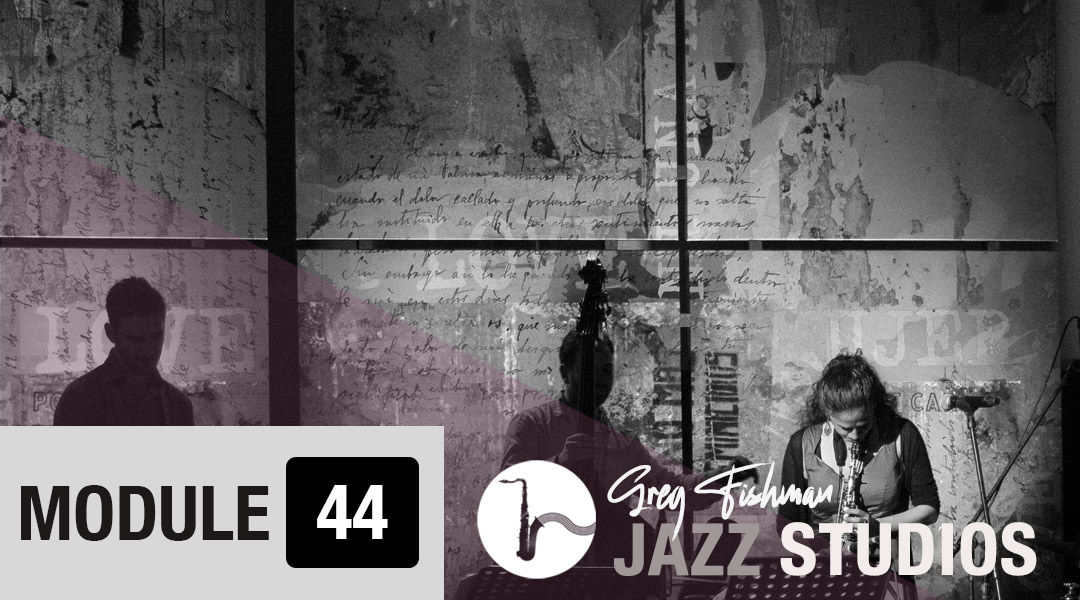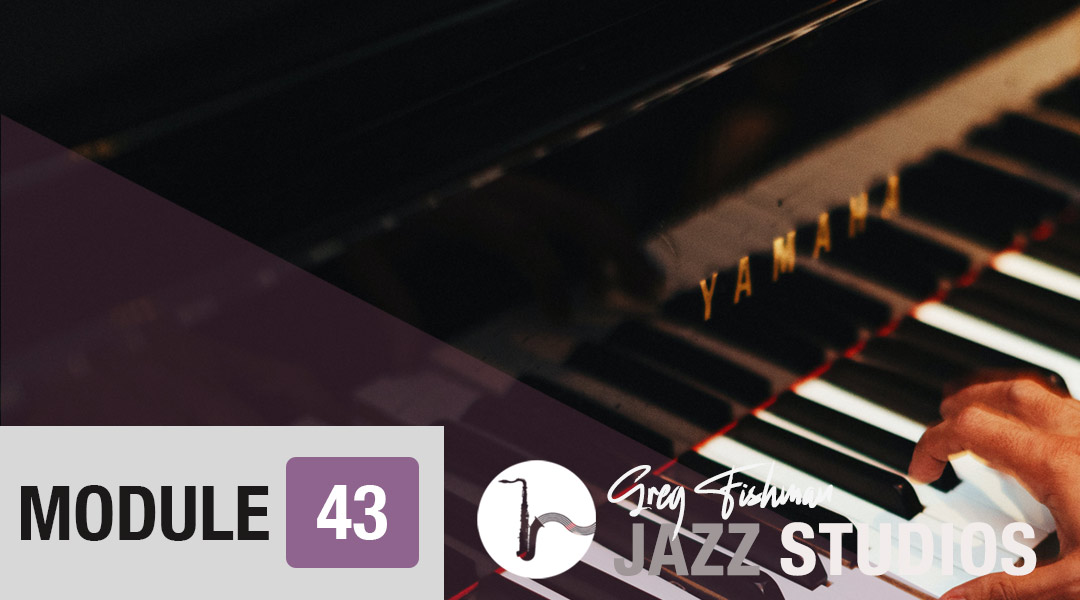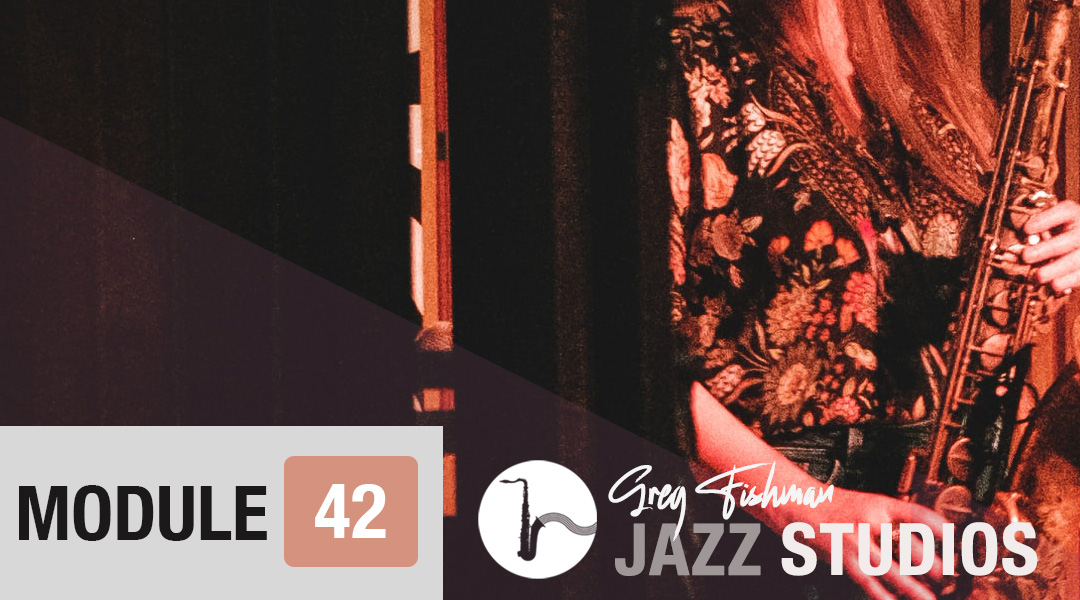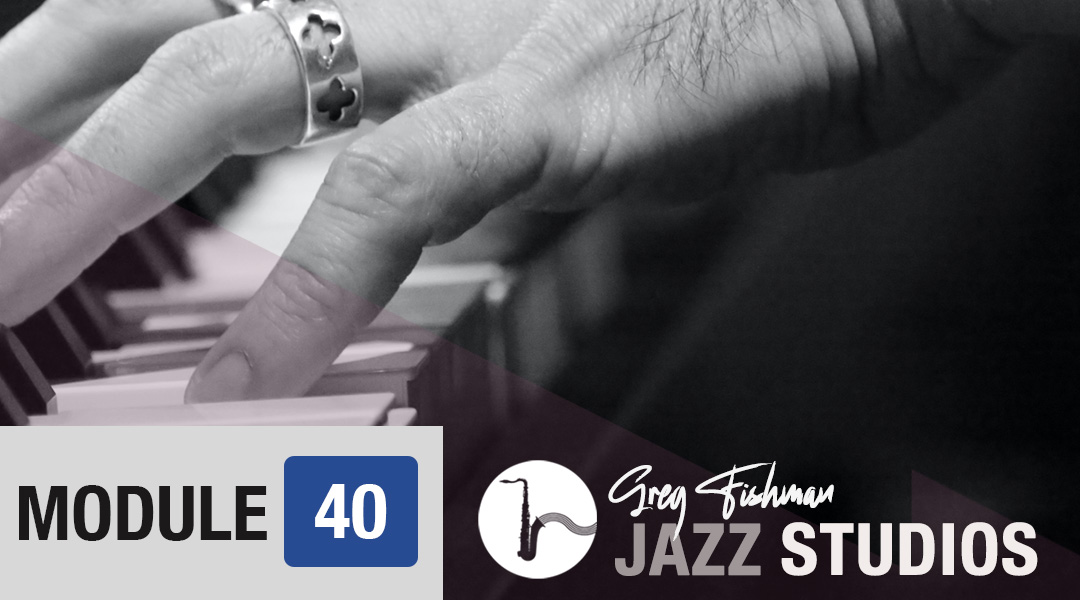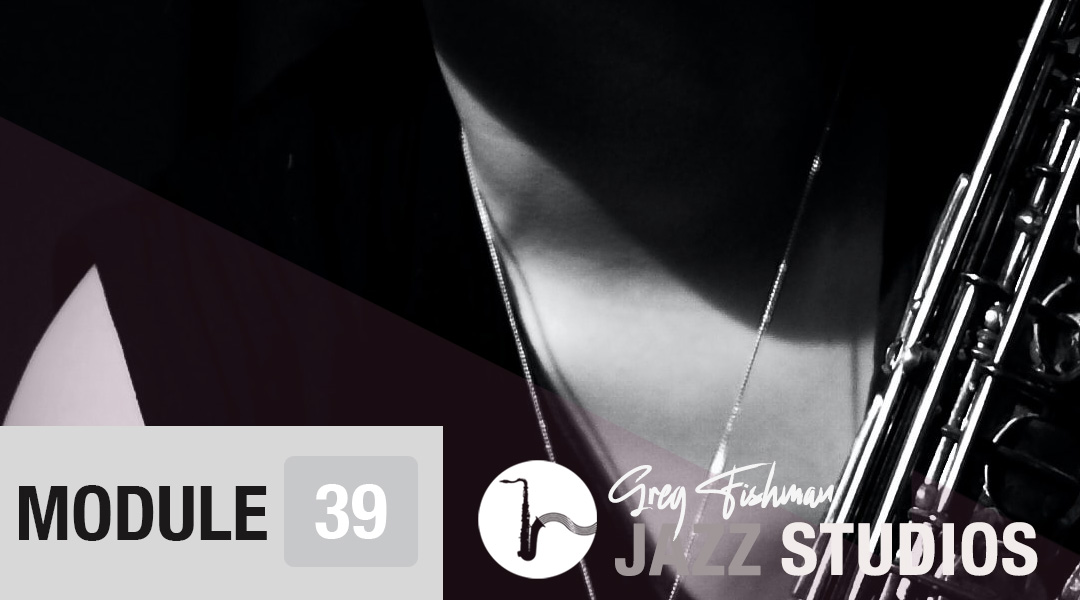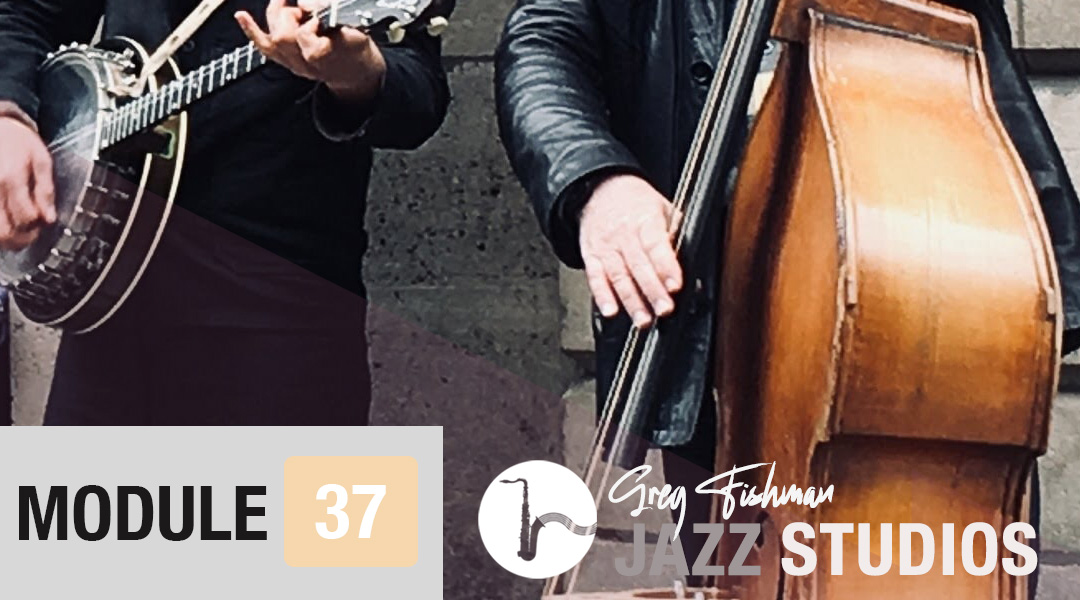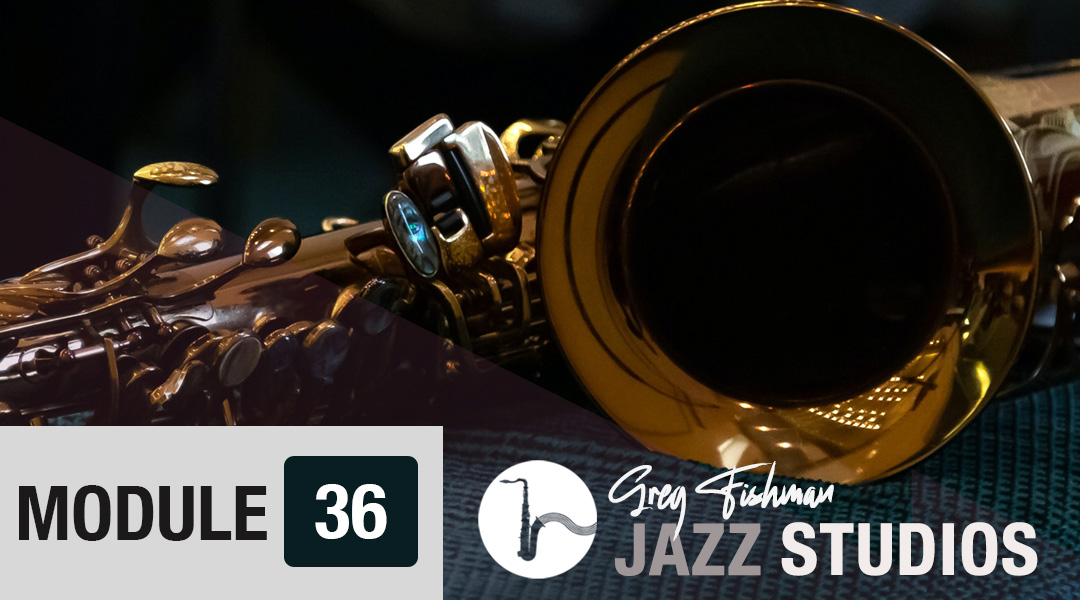5 Lesson course
MODULE 46
4 Lesson course
MODULE 45
4 Lesson course
MODULE 44
5 Lesson course
MODULE 43
4 Lesson course
MODULE 42
5 Lesson course
MODULE 41
4 Lesson course
MODULE 40
5 Lesson course
MODULE 39
4 Lesson course
MODULE 38
MODULE 47
5 Lesson course
MODULE 46
4 Lesson course
MODULE 45
4 Lesson course
MODULE 44
5 Lesson course
MODULE 43
4 Lesson course
MODULE 42
5 Lesson course
MODULE 41
Module 47
LESSON 1: Idiomatic Front F Lick
During a Skype lesson, one of my students was having trouble using his front F key on the saxophone. He couldn’t get comfortable with it. I created this lick to show him how I often access the key.
I refer to this as an “idiomatic” lick because it lays so well on the horn. This is not the only way to use the key, but it’s a good introduction to get comfortable with the unique hand position required for front F.
Includes PDF practice notes.
LESSON 2: Major Seventh Chord Inversions
In this video lesson, I play the major seventh chords in all inversions with what I call the “top margin” of my “C” on tenor, with all notes descending: C B G E (Cmaj7), C Ab G Eb (Abmaj7), C A F E (Fmaj7), and C Ab F Db (Dbmaj7).
Playing the inversions in this manner really highlights the interval structures of the chords and improves the accuracy of the ear. This is a great practice approach for ear training and improved control of your major seventh chords.
Advanced level. Includes PDF practice notes for Bb, Eb and C instruments.
LESSON 3: Getz Double Note Articulation Effect
In this video lesson, I demonstrate a specialized type of articulation that I call the “Getz Double Note Articulation Effect.”
This is a device that I first heard on an album called “Stan Getz Plays.” It gives the illusion of double-tonguing, but it’s single tonguing with very strategically placed slurs.
Learning to use this effect has really improved my control and speed for articulation. This is a great tool to have in your “special effects” bag of tricks to add something unique to your solos.
Includes PDF practice notes for Bb, Eb and C instruments.
LESSON 4: The Blues Scale – Part 1 of 2
In this video lesson, I explore the blues scale. This part one video teaches scale construction and application of the blues scale over a dominant and a minor chord.
I share my thoughts on using the scale over the full range of the horn and demonstrate some popular techniques used by the masters with this scale, including sequencing and repetition.
Includes PDF practice notes for Bb, Eb and C instruments.
LESSON 5: The Blues Scale – Part 2 of 2
This video lesson continues where part one ended, exploring options for adding extra chromatic notes to the scale.
Includes many examples in which I play some of my favorite phrases using the scale with the extra notes.
I also share my thoughts on the overuse of this scale by beginning players and explain why I look at this scale as a sort of musical spice, used to enhance the flavor of a chord progression.
Includes PDF practice notes for Bb, Eb and C instruments.
Module 46
LESSON 1: Introduction to Major Seventh Chord Inversions
In this video lesson, I share my technique for hearing all inversions of a major seventh chord.
I explain why this unique approach helps the ear to hear the differences between the intervallic structures of root position, first inversion, second inversion and third inversions of the major seventh chord.
Includes PDF practice notes for Bb, Eb and C instruments.
LESSON 2: Major Seventh Chord Inversions Echo Game
In this video lesson, I play the major seventh chords in all inversions with what I call the “bottom margin” of my “C” on tenor: C-E-G-B (Cmaj7), C Eb G Ab (Abmaj7), C E F A (Fmaj7), and C Db F Ab (Dbmaj7), followed by the remaining eleven notes in the cycle acting as the “bottom margin notes.”
Playing the inversions in this manner really highlights the interval structure and improves the accuracy of the ear.
This is a great practice approach for ear training and improved control of your major seventh chords. Advanced level.
LESSON 3: Hip Lick #73
In this video lesson, I explore Hip Lick #73 and demonstrate how I adapt the lick to change it from a Bossa Nova style lick into a Swing style lick, with extra notes and less syncopation.
Hip Lick #73 is based on a popular chord progression known as “Parallel Major to Minor.” This means that the chord changes from Cmaj7 to Cmi7. Many of the old standard songs, including Green Dolphin Street, I’ll Remember April, How High The Moon, I’m Glad there Is You, etc., use this chord progression.
The video concludes with and ECHO GAME of the lick in all twelve keys, played in the cycle. Includes PDF practice notes for Bb, Eb and C instruments. Intermediate Level.
LESSON 4: Echo Game with Random Chord Types
I’ve had many member requests for a video in which I play the “big five” chords in the cycle, but randomize the chord types instead of just playing them in a preset order.
In this video lesson, the first half is designed for intermediate players and I reveal each chord type after I leave space for you to echo the chord arpeggio that I have played. The second part of the video is slightly more challenging.
I randomize the chords again through the cycle, but this time I don’t reveal the type played. The final part of this echo game is for more advanced players, with the randomized chords descending from the seventh.
This is an excellent way to improve your ear and your ability to focus on the unique sound of the “big five” chord types: maj7, dominant 7, minor 7, half-diminished and diminished chords. Intermediate & Advanced level.
Module 45
LESSON 1: Tools of the Composer – Jerome Kern’s “I’m Old Fashioned”
In this video lesson, I share my interpretation of a very powerful editing device used by Jerome Kern on the bridge of his famous standard, “I’m Old Fashioned.”
Kern takes something that would have been a very ordinary scale two-note pattern in thirds and transforms it into a memorable melody by editing out one of the notes in the pattern. T
his lesson explores this editing technique and shows you how to apply the concept in your own playing. Includes PDF practice notes for C, Bb and Eb instruments.
LESSON 2: Tools of the Composer – Antonio Carlos Jobim’s “One Note Samba”
In this video lesson, I share my interpretation of Jobim’s use of common tones in the melody over the first four measures of his hit song, “One Note Samba.”
Jobim uses what I call “dual citizen notes” (common tones) to bring out four different flavors from the same repeated note. He achieves this effect by maintaining a repeated pitch in the melody while the chords move downward in half-steps.
I explore this sound and share my approach to transfer this very cool sound to the saxophone. Includes PDF practice notes for Bb, Eb and C instruments.
LESSON 3: Maj7#5 Chords w/Echo Game
In this video lesson, I share my strategy to help a student to the first two chords on the bridge of the popular Brazilian tune, The Girl From Ipanema. I use two upper structures to bring out the sound of the progression.
The first is the very familiar mi7 chord. I use the mi7 chord over the maj7, acting as a 3-5-7-9. Then, I simply lower the root of the mi7 chord to achieve a maj7#5 chord shape. I use the maj7#5 chord shape as 7-9-#11-13 over a dominant chord.
While this may sound complex, it’s very easy for your ear to hear the musical logic of this approach. Includes PDF practice notes for C, Bb and Eb instruments. Echo Game starts at 7:48 into the video lesson.
LESSON 4: If You Can Hear It You Can Have It
In this video lesson, I share a story about a new Skype student who has a music degree and great reading skills, but his ability to play what he hears is not yet fully developed.
After speaking with him about his training, he revealed to me that his former teacher told him to never listen to the sounds in his head and instead, to play by memorizing numbers for the notes. This is contrary to what I learned from Joe Henderson, James Moody, Mark Colby, and all of the many incredible teachers who shared their knowledge with me.
I explain in the video that it’s not just about hearing the sounds, but developing your musical memory and improving your ability to focus on the music.
Module 44
LESSON 1: Six Essential Items for Daily Practice
In this video lesson, I discuss the importance of practicing each item on my practice planner. I developed this approach in my 20’s when I was practicing many hours each day. I experimented with many different approaches to practicing and found that these six items yielded the best results.
Many people get stuck practicing only scales or chords and never seem to get to other items like vocabulary, transcriptions, etudes, and tunes.
Includes PDF practice planner.
LESSON 2: Secret Applications for the Bebop Scale
In this video lesson, I share what I call the “secret” applications for the bebop scale. These are not the types of applications that you learn in school. In both my undergrad and graduate studies, there was no mention of these applications of the scale.
And yet, when I transcribed the masters, I found that they routinely applied the scale in this way when they wanted to get more harmonic flavor from the scale.
If you’ve ever been at a loss for how to use the bebop scale over a minor ii / V situation, this video will show you how to apply the scale like a seasoned professional.
Includes detailed PDF practice notes for Bb, Eb and C instruments.
LESSON 3: Creative Scale Practice
In this video lesson, I share a story about one of my Skype students who was very bored with his scale practice. He was in a rut, always playing his scales like a technical exercise, rather than finding the music hidden within the scales.
I showed him these creative practice strategies that I use in my own practice and he was instantly playing with more energy and creativity while also improving his musical memory and his instrumental technique.
Includes detailed PDF practice notes for Bb, Eb and C instruments.
LESSON 4: C.E.S.H. – What it is and How to Use it.
In this video lesson, I explore and explain C.E.S.H. The term was coined by one of my former teachers, the great Jerry Coker. It stands for “Contrapuntal Elaboration of Static Harmony.” Basically, it means that you apply voice leading to a chord within itself by moving the sevenths (and sometimes the fifths).
This is a common harmonic device used by all pro players. You’ll recognize it as soon as you hear it. I explain the device and break it down in a way that makes it easy for all levels of players to immediately use this in their solos. Includes detailed PDF practice notes for Bb, Eb and C instruments.
LESSON 4: Thumb Position for the Octave Key
In this video lesson, I discuss and demonstrate the importance of good thumb position on the saxophone. This topic is often overlooked. Over the years, I’ve taught many students who needed to correct bad habits with their thumb position. In some cases, students were experiencing pain from using the wrong position or from using too much pressure.
The left hand cannot operate with efficiency without an excellent thumb position, combined with a light touch. If you’ve ever had issues with left-hand technique problems or pain in your left hand or arm due to the octave key, this video will address all of those issues and provide a clear strategy to fix the problem.
Module 43
LESSON 1: The Donkey
In this video lesson, I share my system to develop a strong, consistent tone when changing from the upper register to the lower register. The video lesson focuses, especially on slurred descending octaves.
I explain a common problem of aspiring saxophonists dropping their jaw to get to the low register, which causes a pitch drop to the upper note, as well as a weak sounding lower register. I call this problem, “the donkey” because the sound reminds me of a braying donkey.
This is an essential lesson for tone development. Key elements in this lesson include a discussion of jaw positioning, throat tension, and air support. ESSENTIAL FOR ALL LEVELS.
LESSON 2: TUNES
In this video lesson, I share with you the basic bebop style blues changes that my famous Chicago teacher, Joe Daley showed be when I was studying with him in the 1980s. These are what I consider to be essential blues changes for bebop era blues heads, like Billie’s Bounce, Tenor Madness, Now’s the Time, etc.
There are many advanced options for the blues, but this video will provide you with the essentials to get started. I play the progression slowly, with the chords in all four directions. I also take you through singing the roots of the chords while playing the changes on the keyboard. Includes PDF with these changes for C, Bb, and Eb instruments. Intermediate level.
Includes detailed PDF practice notes for C, Bb, and Eb instruments.
LESSON 3: Mi(maj7) Chords with Echo Game in Four Directions
In this video lesson, I explain how to play minor(maj7) chords. This is one of my favorites. it has a kind of “film-noir” quality to the sound of the chord, with a dark minor third, a neutral perfect fifth, and a very bright major seventh. I often refer to this chord as the “Vertigo” chord because this sound was featured so prominently in Alfred Hitchcock’s classic film “Vertigo,” starring Jimmy Stewart.
This chord is also featured in songs such as: Harlem Nocturne, Nica’s Dream, Chelsea Bridge, Solar, and many more. I take you through the “echo game” in all four directions, with Direction 1 at 2:16, Direction 2 at 4:00, Direction 3 at 5:36, and Direction 4 at 7:10. Starting at 8:08 I have a high-speed echo game for advanced players. At 10:48 I give suggestions for practicing with this chord.
Includes PDF for C, Bb, and Eb instruments.
LESSON 4: Addition by Subtraction
In this video lesson, I share my thoughts on transforming your playing not by adding more and more layers to what you’re doing, but by subtracting things that are holding you back. This is a very powerful concept. Who would have thought you could sound so much better by simply subtracting a few things from your playing?
Module 42
LESSON 1: The Echo Game – Major Seventh Chords with Lower Neighboring Tones
In this video lesson, I play the echo game with major seventh chords, adding lower neighboring tones to the root, third, fifth or seventh. Includes directions one, two and a bonus round of direction three for advanced players.
LESSON 2: The Diminished Scale over a Cº7 Chord – New System
In this video lesson, I share a completely new approach to learning the diminished scale for use with the diminished seventh chord. This is one of the more challenging topics, as aspiring players are often unsure about the notes in between the chord tones of 1-b3-b5-bb7 when playing this scale. This new system eliminates all doubt and will help you to hear the scale with clarity.
Includes detailed PDF practice notes for C, Bb and Eb instruments.
LESSON 3: Major Scales in 3rds Shifting by Half Steps
In this video lesson, I take the familiar practice routine of playing major scales in thirds and put a new twist on it. To improve technical fluency in difficult keys, I shift the exercise both a half-step up and down. This is a great way to get over any inhibitions about playing in tricky keys.
Includes detailed PDF practice notes for C, Bb and Eb instruments.
LESSON 4: Staccato Articulation Strategy – Aka: Duck, Duck, Goose
In this video lesson, I share my unique approach to creating extremely percussive short notes similar to the style used by Stan Getz on many of his famous Bossa Nova recordings. This simple, yet effective approach will definitely transform your short notes.
LESSON 5: The Art of Listening
In this video lesson, I share my thoughts about being aware of your musical surroundings at all times. The first story is about a student with no awareness that he’s playing in the wrong key with a play-along. The second story is about a pro player how he was ignoring his musical surroundings. In both cases, it was a failure to listen that hurt both performances. I discuss the importance of developing the ability to listen and play simultaneously.
Module 41
The Echo Game with Lick #1 Variations
In this video lesson, we’ll play the echo game, in which you will imitate or “echo” whatever I play. I have the metronome at 160BPM and play many variations on Hip Lick #1. Each of my demonstration phrases is one measure in length. You’ll have one measure to play the echo, by ear.
The video is divided into two parts. The first part of the video is intermediate level, with all variations on the lick remaining in the same key. The second half of the video takes all of the variations for the echo and puts the lick into the cycle, playing different variations in each of the twelve keys. This is an ear-training video designed to improve your musical memory. So, by intent, there are no PDF notes for this lesson. INTERMEDIATE & ADVANCED LEVEL.
LESSON 2: Stop Scooping Your Notes!
I think of this video lesson like a public service announcement for all intermediate level aspiring player. In my earliest playing days, I was a guilty of this as anyone. I thought it sounded “jazzy” so scoop into my notes. Wrong! Thanks to my old teacher Joe Daley, who told me in quite harsh terms, but really cured me of doing this, I found a better way, through Sonny Stitt, to get the effect of sliding into a note while maintaining the pitch center of the note.
This video demonstrates how it sounds when scooping and then how it sounds when applying the Sonny Stitt way of using a grace note from a 1/2 step below, to slide into a note. Totally hip. This is designed to be an ear-training lesson, as well, so there are no PDF notes with this one. INTERMEDIATE LEVEL.
No PDF materials for this lesson
LESSON 3: The Bad Toupee Theory – How to Blend Licks into a Solo
In this video lesson, I share what I call my “Bad Toupee Theory.” The basic idea is this: Nobody points to a guy and says, “what a great looking toupee!” They only say “look at that bad toupee on that guy!” If it’s a great looking toupee, you can’t even tell that the guy is wearing a toupee. It’s similar with licks.
You don’t want to make it obvious that you’re using licks. They need to blend into the musical surroundings. In this video, I demonstrate an obvious usage of a lick (bad toupee) and I also demonstrate a subtle way to use a lick, blending it into the development of the solo. Includes PDF lesson notes for Bb, Eb and C instruments. INTERMEDIATE & ADVANCED LEVEL.
LESSON 4: Dealing with Practice Anxiety – How to Have Fun While You Practice
Recently, I’ve been hearing more and more from students of all levels who tell me that they’re constantly stressed out about practicing. They feel overwhelmed and anxious about the amount of musical material they need to master in order to move forward. I used to have these feelings, and it took me a long time to change my attitude and approach turn my practice sessions into really fun experiences. I
n this video lesson, I share my personal journey with you and give you some suggestions that, to this day really help me have fun in every practice session. BEGINNING, INTERMEDIATE & ADVANCED LEVELS.
Module 40
The Echo Game – 60 Chords – Direction 1
In this video lesson, we’ll play what I call, “the echo game.” In this game, I arpeggiate each chord and then leave space for you to “echo” exactly what you heard. For this particular video, I play the chords in what I call “Direction 1,” which means 1-3-5-7, ascending.
This is an ear-training game and there is no written PDF for this lesson (by design). Take your time and do quality work. If you need to just focus on one group of chords, such as the major or dominant, just replay that portion of the video lesson. Use this lesson often to keep your ears sharp, keep up your concentration and review all sixty of your chords, all in a matter of a few minutes. INTERMEDIATE LEVEL.
LESSON 2: The Echo Game – 60 Chords – Direction 2
In this video lesson, we’ll play what I call, “the echo game.” In this game, I arpeggiate each chord and then leave space for you to “echo” exactly what you heard. In this video, I’m playing the chords in “Direction 2,” which means 7-5-3-1 for all 60 chords, starting with the major 7th chords, followed by dominant, minor, half-diminished and diminished seventh chords.
This is an ear-training game and there is no written PDF for this lesson (by design). Take your time and do quality work. If you need to just focus on one group of chords, such as the major or dominant, just replay that portion of the video lesson. Use this lesson often to keep your ears sharp, keep up your concentration and review all sixty of your chords, all in a matter of a few minutes. INTERMEDIATE LEVEL.
LESSON 3: The Echo Game – 60 Chords – Direction 3
In this video lesson, we’ll play what I call, “the echo game.” In this game, I arpeggiate each chord and then leave space for you to “echo” exactly what you heard. For this particular video, I play the chords in what I call “Direction 3,” which means 1-3-5-7, ascending and then 7-5-3-1 descending on the next chord in the cycle.
This is an ear-training game and there is no written PDF for this lesson (by design). Take your time and do quality work. If you need to just focus on one group of chords, such as the major or dominant, just replay that portion of the video lesson. Use this lesson often to keep your ears sharp, keep up your concentration and review all sixty of your chords, all in a matter of a few minutes. INTERMEDIATE LEVEL & ADVANCED LEVEL.
LESSON 4: The Echo Game – 60 Chords – Direction 4
In this video lesson, we’ll play what I call, “the echo game.” In this game, I arpeggiate each chord and then leave space for you to “echo” exactly what you heard. For this particular video, I play the chords in what I call “Direction 4,” which means 7-5-3-1, descending and then 1-3-5-7, ascending on the next chord in the cycle.
This is an ear-training game and there is no written PDF for this lesson (by design). Take your time and do quality work. If you need to just focus on one group of chords, such as the major or dominant, just replay that portion of the video lesson. Use this lesson often to keep your ears sharp, keep up your concentration and review all sixty of your chords, all in a matter of a few minutes. INTERMEDIATE LEVEL & ADVANCED LEVEL.
LESSON 4: Listening Recommendation: Brasil ’66 – Equinox
One of my favorite pop/brazilian/jazzy groups of the 1960’s, Sergio Mendes and Brasil ’66. This is my favorite album of theirs, though they’re all great.
This one, to me, represents an incredible combination of sophisticated writing and orchestration, great studio production, catchy, interesting tunes and a fun, light character. The time feel is so fun with this group. Nothing dark or brooding, though they do have an emotional range, from introspective, longing ballads to fun, uptempo bossa novas and sambas. If you’re not hip to Brasil ’66, this is a great place to start.
If you like this one, be sure to also pick up their first album, Herb Alpert Presents Sergio Mendes & Brasil ’66. Great stuff!
Module 39
LESSON 1: Locating the 9th of a Chord
The ninth is one of my favorite notes in a chord. To me, it always feels and sounds elegant and luxurious. And yet, many aspiring players have a difficult time locating and hearing the note. In this video lesson, I show you my system for easily hearing and locating the ninth of any chord.
This lesson includes hearing ninths over: Maj7, dom7, mi7, mi7b5, and dim7 chords. Intermediate & advanced level. Includes detailed PDF practice notes for Bb, Eb, and C instruments.
.
LESSON 2: Hearing a Hidden Melody within an Eighth-Note Line
In this video lesson, I will take phrase of all eighth-notes and reveal to you the hidden melody within that line. I use a short phrase from my etude, “Broadway Street” and deconstruct the line, revealing the melody that I had in mind. From there, I rebuild the phrase, adding an enclosure, approach notes to reconstruct the line.
This lesson provides insights into the compositional process involved in creating melodic eighth-note lines.
INTERMEDIATE LEVEL. Includes PDF practice notes for Bb, Eb and C instruments.
LESSON 3: High Speed Articulation with Halsted Street
In this video lesson, I share my strategies for increasing the speed and smoothness of your articulation when playing fast, consecutive eighth-notes. I use a short phrase from my etude, “Halsted Street” to demonstrate many different approaches to articulation.
The video also includes some discussion of extended articulation techniques, such as the “dooden” tongue and a demonstration of integrating the “dooden” tongue with the “ah-tah,” and staccato tonguing, all while keeping the phrase in tempo. INTERMEDIATE & ADVANCED level. Includes PDF practice notes for Bb, Eb and C instruments.
LESSON 4: Listening Recommendation: Oscar Peterson Trio: The Sound of the Trio
This is one of my all-time favorite recordings of the legendary Oscar Peterson trio, featuring Ray Brown and Ed Thigpen. This was recorded in the late 1950s in Chicago at the famous “London House,” a jazz supper club in downtown Chicago.
Artists would be “in residence” for their gig from one to three weeks at a time, playing between five and seven nights a week. This led to a wonderfully relaxed situation, where the artists could focus on the music, well-rested, without the fatigue of playing one-niters around the country.
I can hear the energy and communication present in every note of the album. You’ll even hear glasses clinking in the background. It’s like you’re right there in the room with the group. The record is also beautifully engineered by Val Valentin, for the Verve record label. A must-have for any serious collection.
Module 38
LESSON 1: Scale Junction Navigation
In this video lesson, I share my method for connecting various types of scales through a ii V I progression. This is a critical skill for all improvisers, as it gives you the flexibility to switch smoothly from the scale of the current chord to the scale for a new chord Many players are limited in their approach with scales because they think that they need to start each new scale from the root.
This is how scales are often taught in academic settings, but my system shows you how to easily connect the scales through voice-leading, from any note, highlighting the strongest notes in every chord. INTERMEDIATE & ADVANCED LEVEL. Includes detailed PDF practice notes for Bb, Eb and C instruments.
.
LESSON 2: Charlie Parker – Use of Bebop Ornamentation
In this video lesson, I analyze Parker’s use and application of bebop ornamentation. Bebop is an ornate style of jazz, sharing some similarities to baroque classical music in its use of ornamentation. Ornamental notes are what I describe as “sudden sixteenths” which are placed within an eighth-note line to add extra detail and sophistication to the line. In this lesson, I take a Parker phrase and break it down, removing all of the ornaments and then showing you how to use these concepts in your own lines, demonstrating with a line that I composed and then enhanced with the application of bebop ornaments in the Parker style.
INTERMEDIATE & ADVANCED LEVEL. Includes detailed PDF practice notes for Bb, Eb, and C instruments.
LESSON 3: Locating the 13th of a Chord
The thirteenth is one of the most colorful notes in a chord, and yet, many aspiring players have a difficult time locating and hearing the note. In this video lesson, I show you my system for easily hearing and locating the thirteenth of any chord.
This lesson includes hearing thirteenths over: Maj7, dom7, mi7, mi7b5 and dim7 chords. Intermediate level. Includes detailed PDF practice notes for Bb, Eb and C instruments.
LESSON 4: Listening Recommendation: Mel Torme Swings Shubert Alley
One of my favorite albums! Mel Torme at the height of his powers with beautiful pitch, tone, phrasing, taste, and humor. Marty Paich, one of my favorite arrangers, has created an amazing collection of arrangements of popular standards.
I love his instrumentation and the inclusion of the tuba in this ensemble. The engineering is also incredible on this album. It’s like you’re right there in the studio with the guys. Paich is also quite humorous, having the band slyly quoting “Who’s Sorry Now” and “Easy Living” while Mel is singing the tune “Just in Time.”
The band is an all-star cast of top West Coast players at the time — Jack Sheldon on Trumpet, Frank Rosolino on trombone, Art Pepper on alto, Mel Lewis on drums…A must-have for any collection.
Module 37
LESSON 1: Rollins & Coltrane Ornaments
In this video lesson, I demonstrate two of my favorite approaches to bebop ornamentation, based on my observations of Rollins and Coltrane and the way that they dress up their lines with ornaments. Intermediate & Advanced level. Includes detailed PDF practice notes for Bb, Eb and C instruments.
LESSON 2: The Jackpot 7-7-7 – Hearing a major scale over a II V I
In this video lesson, I show my technique for harmonically aligning a major scale over a ii V I. This strategic approach provides great clarity and voice leading, giving you all 3’s, 5’s, 7’s or 9’s over a ii V I while simply playing a diatonic scale.
A key factor is setting up your ear to hear the roots of the chords in relation to the starting note of the line. I demonstrate the process throughout the video lesson. Intermediate & Advanced level. Includes detailed PDF practice notes for Bb, Eb, and C instruments.
LESSON 3: Speed Bag – Cool Minor Lick
In this video lesson, I share one of my favorite minor patterns that I used for working up my technique.
This is a short but very effective lick for improving your precision on the keys, as well as improving alignment between your articulation and fingers. ALL LEVELS. Includes detailed PDF practice notes for Bb, Eb and C instruments.
LESSON 4: Greg’s Philosophy of Music: Playing by Theory vs Playing by Ear
In this video lesson, I discuss the difference between playing by theory and playing by ear. I share many examples from my years as a student and later observations from the perspective of a pro player and teacher.
If you’ve been trying to figure out music theory to make up for the possibility that your ear isn’t all that developed, this video will really shed some light on the reason that the theory (as much as I enjoy it) is no substitute for a highly trained ear. I’m not saying that theory isn’t important, but when it comes to playing jazz and improvising, the ear must be first, not the intellect.
LESSON 5: Listening Recommendation: Frank Sinatra: Point of No Return
For me, Frank Sinatra was the greatest singer, ever. He had it all…perfect intonation, diction, dynamics…the way he could tell the story of the lyrics in a way that felt like he was speaking directly to the listener. And, his phrasing…the breath control…astounding.
This album isn’t one of the most popular, like Live at the Sands, or Come Fly With Me (both equally good, but different). This is a mellow, introspective Sinatra, not the ring-a-ding Sinatra. Axel Stordahl’s arrangements are great examples of beautiful, clear, uncluttered orchestration. Like all of Sinatra’s Capital album’s, the engineering is top notch, sounding like it was recorded today.
Module 36
LESSON 1: Mirrored Intervals
In this video lesson, I share a concept that I call “mirrored intervals.” By this terminology, I’m referring to the sound of playing, let’s say, an E up to a G, and then playing the same E again, but dropping to the G below. The result is that you’ll go up a minor third and the “mirrored” interval produced when you drop down to the G below E will be a major sixth. One of my favorite players, Gene Ammons uses this device quite a bit in his solos. In this lesson, I’ll demonstrate several ways to practice this concept and get it into your playing. Intermediate & Advanced level. Includes detailed PDF practice notes for Bb, Eb and C instruments.
LESSON 2: Fixing the Break: How to play smoothly from C to D
One problem for many aspiring saxophonists is “the break,” which is the part of the horn that switches from the lower register, without the octave key, to the upper register, with the octave key. The break can be especially challenging when going from middle “C” to middle “D.” The thing that many aspiring players don’t realize is that while there’s just one key to press on the horn, there are actually two octave keys. One is located on the neck, and the other is located on the body of the horn. In this video lesson, I demonstrate both the problem and the solution. Includes close-up camera shots of my hands as I play the horn. If you’ve ever wanted to smooth out your transitions from the low register to the middle register of the horn, this video will immediately put you on the right path.
CLICK HERE to download PDF lesson materials
LESSON 3: The Harmonic Minor Scale
In this video lesson, I demonstrate the harmonic minor scale, first comparing it to the major scale, and then showing how to use it strategically over a minor ii / V / I. I also demonstrate the scale in 3rds in the four directions, followed by an improvisation on the scale. Includes detailed PDF practice notes for Bb, Eb & C instruments. INTERMEDIATE LEVEL.
LESSON 4: Greg’s Philosophy of Music: It’s Bigger than You and Me
In this video lesson, I discuss my thoughts about a student who came to me feeling down about his playing. He is a good student. He practices a lot. He always shows up prepared for the lessons. I’m proud of his progress. And yet, he had such negative feelings about his playing that he was considering quitting.
I shared my personal philosophy about music with him and told him about my own experience with feelings of frustration and self-doubt as a younger player. After I shared these thoughts with him, we proceeded to have a fantastic lesson and by the end of the lesson, he was feeling much better about things. I hope that you enjoy the video.
LESSON 5: Listening Recommendation: Cannonball Adderley – Somethin’ Else
An all-time classic 1958 Blue Note album. Miles Davis rarely appeared as a sideman after his time with Charlie Parker, but he made a rare exception and appeared on this Cannonball album. There’s great chemistry between all of the players on this album.
The vibe, the grooves…this is one of those albums that just sets a great mood and when it’s finished playing, you want to play it all over again. My favorite track, “One for Daddy-O” features one of my all-time favorite alto solo breaks. Also includes classic renditions of “Autumn Leaves” and “Love for Sale.” A must for all jazz collections.

